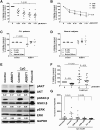PKC-β as a therapeutic target in CLL: PKC inhibitor AEB071 demonstrates preclinical activity in CLL
- PMID: 25001469
- PMCID: PMC4148770
- DOI: 10.1182/blood-2014-05-574830
PKC-β as a therapeutic target in CLL: PKC inhibitor AEB071 demonstrates preclinical activity in CLL
Abstract
Targeting B-cell receptor (BCR) signaling in chronic lymphocytic leukemia (CLL) has been successful with durable remissions observed with several targeted therapeutics. Protein kinase C-β (PKC-β) is immediately downstream of BCR and has been shown to be essential to CLL cell survival and proliferation in vivo. We therefore evaluated sotrastaurin (AEB071), an orally administered potent PKC inhibitor, on CLL cell survival both in vitro and in vivo. AEB071 shows selective cytotoxicity against B-CLL cells in a dose-dependent manner. Additionally, AEB071 attenuates BCR-mediated survival pathways, inhibits CpG-induced survival and proliferation of CLL cells in vitro, and effectively blocks microenvironment-mediated survival signaling pathways in primary CLL cells. Furthermore, AEB071 alters β-catenin expression, resulting in decreased downstream transcriptional genes as c-Myc, Cyclin D1, and CD44. Lastly, our preliminary in vivo studies indicate beneficial antitumor properties of AEB071 in CLL. Taken together, our results indicate that targeting PKC-β has the potential to disrupt signaling from the microenvironment contributing to CLL cell survival and potentially drug resistance. Future efforts targeting PKC with the PKC inhibitor AEB071 as monotherapy in clinical trials of relapsed and refractory CLL patients are warranted.
© 2014 by The American Society of Hematology.
Figures






References
-
- Burger JA, Gribben JG. The microenvironment in chronic lymphocytic leukemia (CLL) and other B cell malignancies: insight into disease biology and new targeted therapies. Semin Cancer Biol. 2014;24:71–81. - PubMed
Publication types
MeSH terms
Substances
Grants and funding
LinkOut - more resources
Full Text Sources
Other Literature Sources
Research Materials
Miscellaneous

